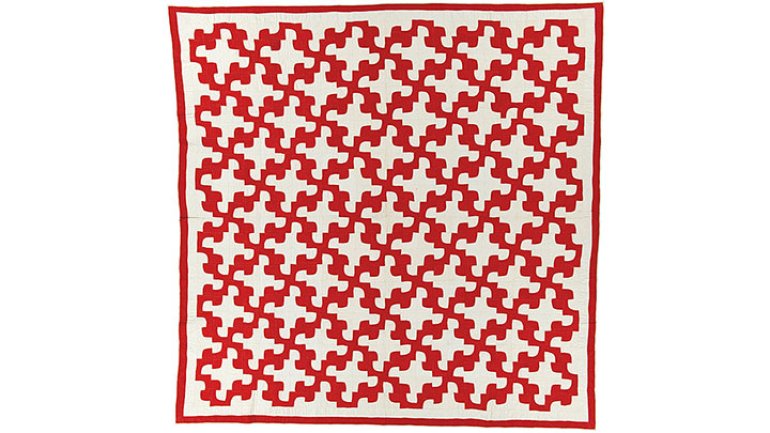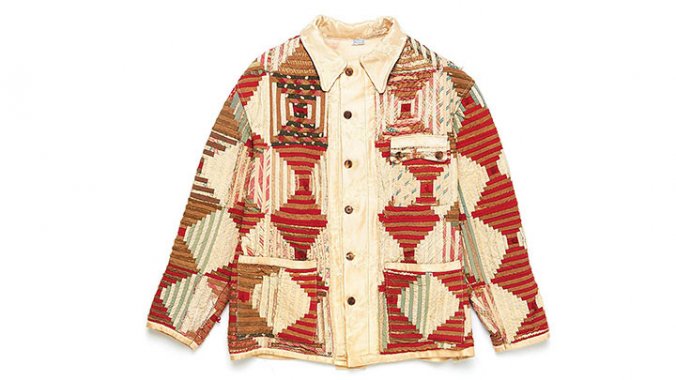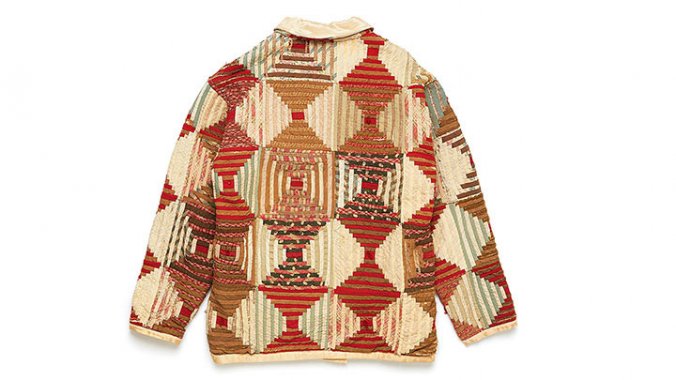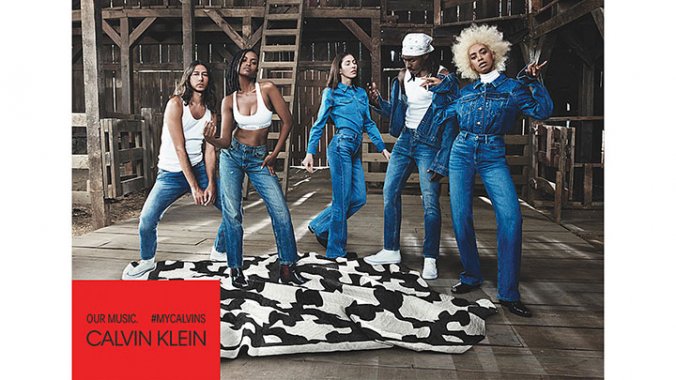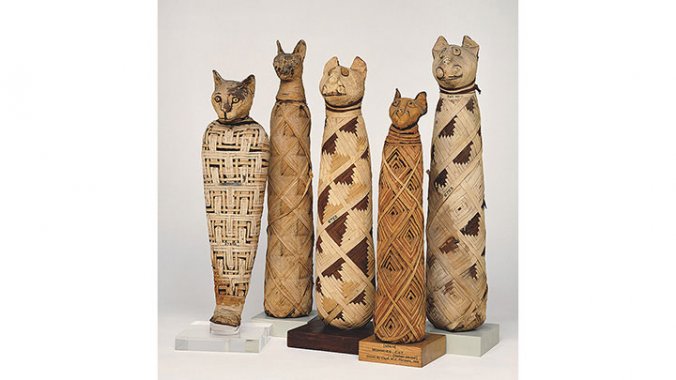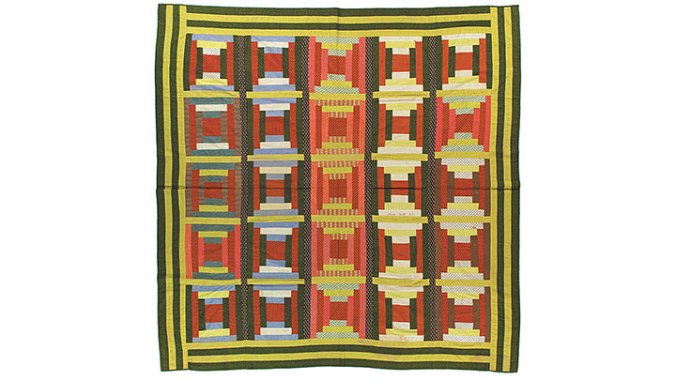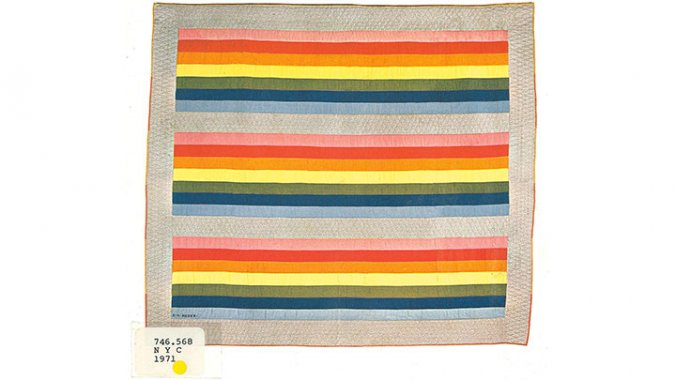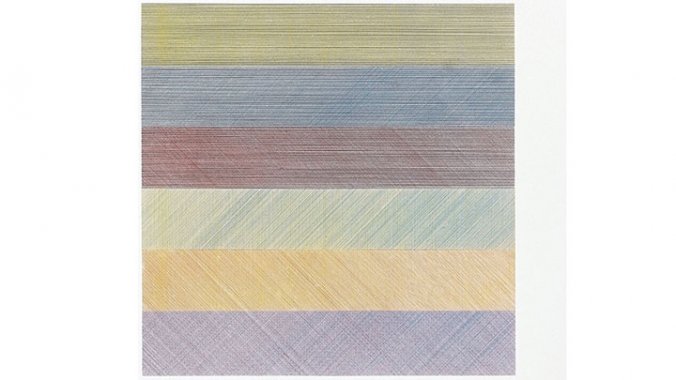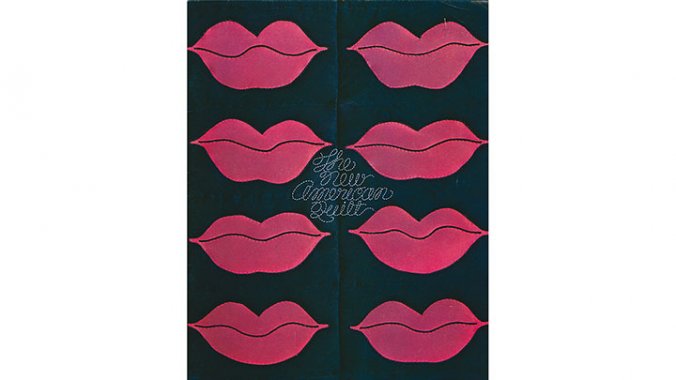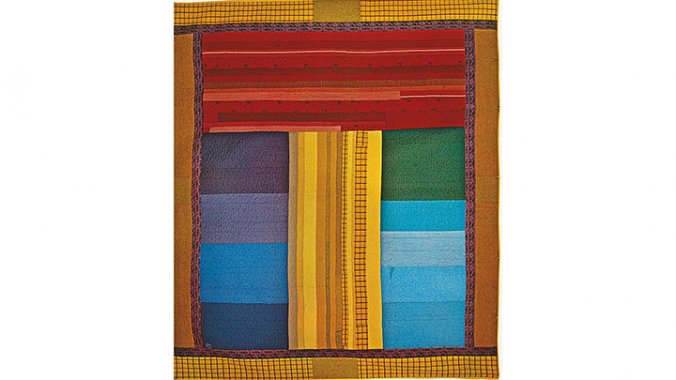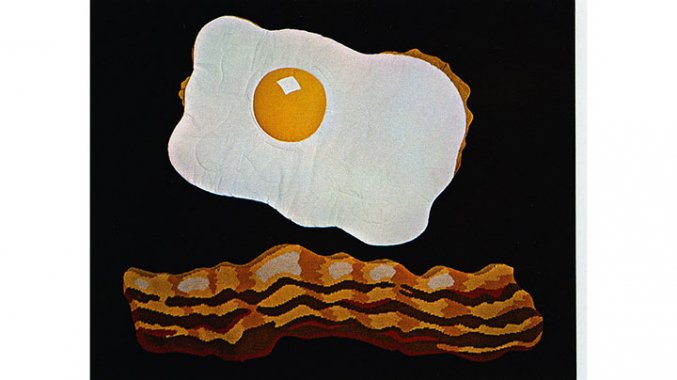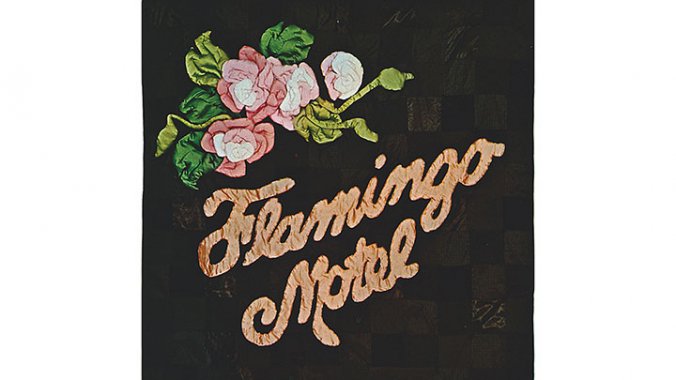Drunkard’s Path: A Meandering History of Quilts
From American Craft Inquiry: Volume 2, Issue 2
Choosing from an archive of material, an unknown quilter used thin strips of solid, plaid, and print fabrics, in a palette of cream-white, red, dusty teal, forest green, and pale brown, stitched together a Log Cabin pattern coverlet. This quilter evenly spaced the fabric strips, three-eighths of an inch wide by 4 inches long, creating the effect of tiny squares surrounded by outward radiating geometric ripples. On the interior of this textile now, a tiny tag is sewn into the design near the top edge; it reads “BODE.”
This particular quilt is no longer a bedspread. It has been tailored into a boxy, long-sleeved jacket with three front pockets. The inscription, Bode, indicates the garment’s designer, not the person or persons who made the quilt originally. A New York-based designer, Emily Adams Bode established her line of menswear in 2016 after working in retail and training at Parsons School of Design.1 On her website, she describes this piece as a “warm-tone log cabin jacket” made from an antique American wool quilt. To offset the geometry of pattern and broad lines of the jacket, the collar and lining are made from a luminous cream-colored floral jacquard silk blend. It is an intriguing piece of clothing. This example is one of many that highlights an ongoing history of quilt2 appreciation and appropriation in American fashion and cultural history.
Bode’s work has been making headlines. In May 2018, she dressed musician Childish Gambino (aka Donald Glover) for his debut of “This Is America,” performed on Saturday Night Live and a major media event. He wore Bode’s trousers made from 1950s Côte d’Ivoire “country cloth,” a type of fabric that is woven in narrow strips on hand looms and pieced together to make larger bolts.3 In “This Is America,” Glover acutely critiques gun violence, racism, and the entertainment industry. Glover’s choice of pants to debut the song suggests pertinent connections between textiles and “Americanness,” as well as between both of these elements and the country’s history of racial oppression and tension. Other brands such as Calvin Klein also use quilts to evoke a sense of Americanness and imply a connection to a lineage of handmade items.
Quilts have had a firm place in American fashion since the 1970s, when patchwork designs and the U.S. Bicentennial were trending. Current trends thus draw on decades-long tendencies that inspire new interest today in the quilt as an aesthetic object and how the deeper histories of quilts and their patterns lend an apparent authenticity to “American” objects. Bode’s transformation of vintage textiles into high fashion, along with acts such as Glover’s, to transform the garment by wearing it, grounds an interest in how certain quilts or cloths become imbued with value and meaning.
Bode grew up in Georgia, antiquing with her mom and aunts during summers at a family home in Massachusetts. She sources her textiles mostly from the Northeast, where she goes to flea markets and works with dealers. On her choice to use antique quilts as clothing, Bode explains, “I want to archive histories and family narratives for future generations. We need a new way of holding on to these beautiful items. ... I’m trying to evoke sentimentality for the past by creating new heirlooms.”4 In addition to quilts, Bode amasses other textiles for her couture collections, including vintage upholstery fabrics and country cloth from the West African Republic of Côte d’Ivoire. The fashion writer Max Lakin observes, “Bode approaches her practice as … restoration and archiving;”5 largely, he praises her practice of channeling reverence for vintage textiles into her designs.
Bode’s work is part of an upsurge in the creative reuse of quilts and quilting techniques by influencers in the fashion industry. In the winter of 2018, quilts in the meandering Drunkard’s Path pattern surfaced in a series of images promoting #mycalvins, an underwear line by Calvin Klein. In one image, model and reality-show star Kylie Jenner stands at the far left of a group portrait with her sisters.6 Turned away from the viewer, she looks back at the camera and holds a quilt with her left arm to cover her otherwise bare torso. Even from what little we can see of the textile, the pattern’s blocky curvature gives itself up as Drunkard’s Path, a distinctive design characterized by criss-crossing asymmetrical wavy lines.
Not only fashion magazines, but also quilting blogs were aflutter with a series of photographs that pictured the Kardashian-Jenner women lounging in a barn surrounded by red-and-white quilts, with headlines such as “The Quiltdashians,” “Quilting with the Kardashians,” and “The Quilt Goes High Fashion.”7 Elle magazine went so far as to “interview” one of the quilts that draped over the Kardashians.8 Quilters were generally glad to see quilts featured in the photos and in Calvin Klein storefronts, though the fashion writers seemed a bit more surprised at the increasing presence of quilts in their milieu. Calvin Klein’s Belgian-born creative lead, Raf Simons, considers the brand itself an American symbol.9 His choice to pair models with quilts is consistent with this view as a way to tether the brand to a handmade history of lovingly crafted clothes and quilts.
Besides the Kardashian-Jenners, Solange Knowles and A$AP Rocky are also featured in the Spring 2018 Calvin Klein print campaign, each pictured with myriad quilts. Even the company’s flagship New York store on Madison Avenue displays several subdued quilts hung dramatically against the bright “OSHA yellow” of the multi-story space. For the spring collection, only one garment features quilts functionally, as a lining for parkas. Mostly quilts are used as props: Models carry these American emblems on the runway in carefully arranged bunches, precariously draped between their left hand and left thigh as they walk. For this purpose, each runway quilt was emblazoned with three lines of large black sans-serif text in all caps: CALVIN KLEIN ESTABLISHED 1968 / DESIGNED IN AMERICA / CONCEIVED IN NEW YORK 205 W39TH ST. Here, perhaps, a point of contrast: While Bode’s approach to quilts manipulates them as memory-laden material to work with, the Calvin Klein brand uses quilts as a symbol, a shorthand claim to Americanness and an implied history.
A black-and-white iteration of Drunkard’s Path is the foundation for the Solange Knowles photoshoot, which showcases the musician, her creative community, and crisp Calvin Klein denim.10 The choice doesn’t appear to be incidental. The brand describes the group pictured as Solange’s musical family and suggests that the “cast embodies a patchwork of strong individuals.”11 This patchwork analogy of fitting parts together and visioning a whole also occurs in the media coverage of her music. One critic described her music as “a patchwork quilt of found sounds.”12 The album the critic describes, “A Seat at the Table,” is about being black in America; as Solange explained, the album was a way to “take pride and celebrate our journey and look at where we came from and look at where we are today.”13 Textiles, like music, create pathways to trace personal and cultural histories. In the print ad, denim-clad Solange, Kelela, Dev Hynes, Caroline Polachek, and Kindness all appear to dance gently on the quilt, which lies on a barn floor.
While Bode and Simons use heirloom textiles in different ways to solidify a brand, the quilts they reference and reuse are already icons. They stand for general ideas of Americanness and identity, even as their legible patterns also reveal deep histories that complicate a simple view of either. The origin of the Log Cabin pattern is debated, as so many patterns are, and it is likely that variations of the basic pattern developed in different areas of the world at various times. Some cite the Roof pattern, with origins traced to the Isle of Man, arguing that the basic pattern came to the United States from Britain in the 18th century. The Log Cabin pattern may have developed in the 1860s. Indeed, some attribute its rise in popularity to the use of the log cabin as an icon in Abraham Lincoln’s presidential campaign, to evoke the myth of pioneering homesteaders building a new nation. At any rate, the pattern became quite popular in the United States by the 1860s.
The Log Cabin pattern may even have roots in the ancient world. Wrapping the physical bodies of dead people and animals is an ancient art of reverence and religion. In Egypt, priests and embalmers carefully wrapped bodies in hundreds of yards of linen strips. Animals, as well as people, were preserved for the afterlife in this intricate manner. This practice developed over thousands of years, from about 2600 BCE and during the Roman period (30 BCE – 641 CE). Extant examples of animal mummies show intricate designs that Egyptians developed using linen strips of fabric. In one instance, housed now at the British Museum, a cat has been preserved in an oblong, narrow oval shape, wrapped in fabric that’s been methodically layered to create a nested square pattern that strongly resembles the Log Cabin pattern.
Ancient mummies such as this Log Cabin example first came to the attention of American audiences during the 19th century. From 1798 to 1801, Napoleon invaded parts of Egypt in a failed attempt to establish a French imperial presence in the Middle East. In addition to the human violence wreaked by the military invasion, Napoleon’s officials pillaged ancient monuments and brought mummies plus other stolen goods to Europe. This invasive practice of tomb raiding, and the publicity surrounding the resulting artifacts, contributed to European and American interest in ancient cultures. Ancient revivalism and so-called Egyptomania of the 19th century informed the conversation about national identity in the United States, which was deeply contested during this period; Egypt became a key model of nationhood and culture for Americans at the time.14 In the 1820s, people visited Rembrandt Peale’s Baltimore museum to see the first dynastic Egyptian mummy to cross the Atlantic to the US.15 Decades later, people flocked to Boston’s Baptist Tremont Temple to watch a mummy being unwrapped over the course of a few days.16 Events such as these would have enjoyed lots of publicity, and engravings of the mummies and other aspects of ancient Egyptian culture circulated widely.
By the 1860s, the struggle to end slavery led to questions about the kind of nation people were building in the United States. In this climate, even mundane tastes for quilt patterns and high-culture tendencies for architectural styles were pointed statements on identity. People looked to ancient Greek, Roman, and Egyptian societies as models for democracy. Architectural styles also echoed these revivalist energies; neoclassical government buildings such as courthouses, with their huge columns and triangular pediments, announced their ideals for a just democratic country. Massive steps lead up to the entrances of neoclassical buildings, each step narrower than the last as they progress inward toward the small square of the entrance door. Shadows cast from the sun onto these steps create a light-dark pattern which is echoed in the quilt version of this architecture of ideals. The Courthouse Steps pattern became a variation on the Log Cabin, emphasizing the stairs ascending to the place of justice.
Other quilting patterns carried even weightier symbolism for what freedom meant in 19th-century America. Prior to and during the American Civil War, makers designed quilts not only to symbolize political change and/or to cover beds and warm family members, but also to guide people enslaved in the South to find their way North, where they might be free. Evidence suggests that specific quilt patterns were hung outside homes indicating safe sites for people traveling along the Underground Railroad.17 The Flying Geese pattern indicated a mnemonic for how an enslaved person could travel by following the migrating geese to the North. In quilts of this kind, artists arrange small triangles to resemble the birds flying, as observed from the ground.18
Returning to the Drunkard’s Path pattern, we observe with new sensitivity how its blocky, zig-zagging lines expand across a diagonally oriented grid.19 Spaces created by contrasting fabrics start to look like complex puzzle pieces or broken pinwheels. The Drunkard’s Path is windy and hard to follow. According to multiple scholars on quilt history, this pattern’s wavering lines echo the advice that such a quilt might convey: to move in a zig-zag and to double back sometimes to evade anyone who might try to follow and recapture you.20
An example from the extraordinary archive at the International Quilt Study Center and Museum (IQSC) in Nebraska allows us a closer look at the architectural elements of the Log Cabin pattern using the Courthouse Steps variation. In this piece by Mary Groff, dating from 1871, the small red centers of each square represent the central fiery hearth of the home. The fabric strips of each side of the square meet at clean angles like the notch-and-pass joints used to build a cabin out of timbers. Groff used lighter fabrics for the top and bottom of the squares, evoking the look of those wide, neoclassical steps.
The Log Cabin quilt at the IQSC found its way to the museum through Jonathan Holstein, who donated more than 400 quilts to the institution in 2003. Holstein was a curator and collector who was pivotal to the East Coast high art embrace of the American quilt. Gail van der Hoof was an artist and designer who traveled extensively, honing her interest in textiles, before meeting Holstein in 1967. In the late 1960s, the pair began collecting quilts with an for eye bold designs that reminded them of the abstract art popular in New York galleries at the time, such as that of Barnett Newman and Sol LeWitt. Holstein and van der Hoof traveled through rural New England working with dealers and small shops to build their collection.21 They were enamored of straightforward pieced patterns with blocky stripes, squares, and shapes, which were quite different from the intricate, appliquéd types of quilts that auction houses and museums were interested in at the time.
In the 1960s when Holstein and van der Hoof were collecting, quilts were often acquired by a museum’s decorative arts department, with craftsmanship and unique designs as criteria for collecting. This designation of quilts as useful craft and not fine art motivated Holstein and van der Hoof to assemble an exhibition of their quilts specifically for an art museum, rather than for a craft-focused venue like the American Craft Council’s Museum of Contemporary Crafts, which they had considered.22 Holstein felt “the exhibition would have been lost” at a place such as the MCC, where everyday objects were already commonplace.23
In what was perhaps the biggest achievement of their taste-making efforts, Holstein and van der Hoof mounted "Abstract Design in American Quilts" at the Whitney in 1971. It was the first exhibition to consider and display quilts as art objects. The cover of the exhibition catalogue showed a rainbow-striped quilt made as a coverlet, in which the stripes run the length of the bed vertically, from head to toe. For the catalogue and the exhibition, the quilt was hung with the stripes running horizontally, a decision signaling Holstein and van der Hoof’s high art ambitions. They wanted their quilts displayed on white walls like paintings or prints by artists such as Newman or LeWitt. In fact, a Newman retrospective followed the quilt show on the Whitney exhibition calendar, and just a year before the quilt show opened, LeWitt made the Composite Series of prints, one of which consists of six subtly colored horizontal stripes fit neatly into a square arrangement. Another LeWitt print features nine squares in a grid, each with triangular patterns resembling sketches of block quilt patterns. Perhaps readers can reimagine LeWitt’s geometric explorations as a nod to the designers of historic quilts, rather than as abstractions from another lineage of design.24
"Abstract Design in American Quilts" at the Whitney included more than 60 quilts hung like large paintings, with designs that likely seemed familiar to gallery-goers and collectors despite the medium. The exhibition was a hit, and it spurred conversation about quilts. During the show’s run, Vogue magazine noted the Whitney show in its “People are Talking About” section.25 Press coverage was wide, and Holstein published a quick follow-up to the exhibition catalogue called American Pieced Quilts (1972). The show had a major impact, alerting new audiences to an established craft, but Holstein and van der Hoof were not the first to bring quilts to an East Coast art-collecting audience.
A few years beforehand, in 1966, Francis X. Walter, an Episcopal priest and white man from Alabama, set up an auction of quilts in New York City to benefit black artists in his native state. Walter developed an interest in quilts while working in Alabama to support civil rights activists. After the Selma-to-Montgomery march in 1965, Walter, other clergy members, and students formed the Selma Inter-religious Project (SIP) to support activists who had increasingly become targets of harassment and hate crimes. Walter traveled through the south-central region of Alabama to document instances of harassment. As he ventured through Possum Bend, he passed the home of Ora McDaniels, where a few bold quilts on a clothesline caught his eye.26 Struck by the talent of McDaniels, as well as the poverty he saw in the region, Walter quickly resolved to support a black community of makers by selling their quilts at premium prices to East Coast collectors eager to support both artists and the civil rights movement. The initial auction helped establish a craft cooperative known as the Freedom Quilters Bee, which began with 60 members led by Callie Young and Estelle Witherspoon.27 The idea was to generate more income for Young, Witherspoon, McDaniels, and other quilters by selling them to wealthy collectors who wanted to support a “worthy and urgent cause, and, in the process, acquire a totally handmade QUILT that is a genuine example of folk art.”28 By the end of 1966, the Freedom Quilting Bee had a contract with interior design firm Parish-Hadley, for which the maker-members made quilts that were used in decorative items such as throws, pillows, and upholstery.29 The artists eventually had to make quilts solely for corporate commissions (rather than the on-spec model that the initial auctions supported); so, while the scenario was not ideal in terms of creativity, the Bee lasted until 2012 and was financially important for the quilters.30
With the activity of the Freedom Quilting Bee and exhibitions such as "Abstract Design in American Quilts," the buzz around quilts was strong by the late 1970s. Quilts had become new commodities for collecting, new raw materials for high design, and artists were experimenting with the form. A 1976 show, "The New American Quilt" at the Museum of Contemporary Crafts, featured 38 new quilts by 25 different artists. Jonathan Holstein contributed a short essay to the exhibition catalogue, writing that an American aesthetic in quilts emerged after a generation of New World quilters brought methods with them from Europe.31 Holstein suggests that the pieced block quilt process – cutting the necessary geometric pieces first and stitching together as time allowed – became a “typically American solution” that efficiently allowed for interchangeable parts and a wide range of design possibilities.32 For the gallery display, the exhibition’s curator, Ruth Admur Tanenhaus, included a slideshow of quintessentially American antique quilts, perhaps to provide both context and contrast for the dynamic, innovative quilts featured in the show.
In the show’s catalog, Tanenhaus wrote that while many quilters work with “time-honored patterns, the artists represented in this exhibition have transcended the historical quilt form by utilizing novel treatments to realize fresh images in fiber.”33 The show included new perspectives in quilting and featured numerous artists who worked with or departed from the quilting traditions from their countries of origin as immigrant Americans. Works included inventive methods such as sculptural appliqué, silkscreen, batik, and photosensitized cloth in order to contribute to the growing genre of contemporary art quilts. Artists like British-born Ros Cross and Susan Fenske incorporated kitsch and humor in their work, creating a quilt shaped like a fried egg and another with ornate appliquéd flowers, respectively. Other artists stuck with more reserved designs but used colors and materials that pushed the craft. For example, Bulgarian-born artist Radka Donnell made Das Grosse T with bold cotton fabrics of golds, blues, and reds.
Quilts have been consistently reimagined and repurposed since the Freedom Quilter’s Bee and the catalyzing exhibitions of the same era. The tradition of continuation and change would continue to intersect with American questions of politics and identity. In the 1980s, a collaborative quilt became a growing memorial to the thousands of people dying from AIDS. Cleve Jones started the NAMES Project AIDS Memorial Quilt in San Francisco and traveled all over the nation to add squares for mourners. In 1987, the quilt was displayed on the National Mall in Washington, DC, where half a million people visited the quilt in one weekend. The 1,920 panels of that quilt not only raised awareness but also raised money for organizations supporting people living with AIDS. As of 2018, the quilt has nearly 50,000 squares – an evolving archive.34
The 1990s saw efforts to preserve these decades of the medium’s expansion. In that decade, the International Quilt Study Center (IQSC) in Nebraska, to which Holstein donated his quilt collection, was established as a major institution to preserve, display, and research quilts from around the world. Technology aided the push to protect and study historic quilts, and enabled new possibilities for the quilting process. The online Quilt Index was established, which documents more than 50,000 quilts with photographs, detailed provenance, and pattern information.35 Computerized sewing machines created new options for programmable stitches in quilting. Also in that decade, story-quilt artist and painter Faith Ringgold opened a major retrospective at the Fine Arts Museum of Long Island, an exhibition that toured 12 other venues nationwide.36 In 2003, 30 years after Holstein and van der Hoof’s groundbreaking exhibition, "The Quilts of Gee’s Bend" graced the walls of the Whitney. The show toured for six years at 12 venues across the country, once again bringing the story of black Alabaman quilters to a museum-going, art-collecting audience.
The histories of quilts in the United States are also histories of race, democracy, and civil rights. Perhaps readers can understand quilts anew as a deep archive of material and meaning and see with new eyes what contemporary designers and tastemakers are activating. Calvin Klein likely includes antique quilts in their ads for a number of reasons. Quilts anchor the firm’s contemporary designs with an American pastoral aesthetic and provide a subtle visual link to raced American identities. The quilts suggest an appreciation for handmade items and their longevity. But this juxtaposition of historical quilt craft with contemporary factory-made clothing might also raise questions about the role of the hand (and whose hand?) in contemporary fashion. The “slow fashion” movement has been calling out such issues since 2007, advocating for clothing whose sale and production supports human and animal rights, considers the ecological impact of production, and lasts a long time. New slow fashion brands, which might be said to include Bode, are quite expensive. While quilts have long been improvised with material at hand and not often intended for sale, the cost of a Bode quilt jacket starts at about $1,300.
Still, Bode’s work has enlivened media outlets from quilt blogs to fashion magazines. This in itself is an illustration of how quilts connect disparate audiences. By giving old textiles new purpose, Bode’s work also pays homage to the original quilters and designers who made the palette of textiles with which she works. In Bode’s Log Cabin/Courthouse Steps jacket, the original quilt artist’s skill is visible in the even piecing, clever colors, and strong stitching. With this new use of the quilt, complete with careful hand-tailoring, it may continue to cover wearers for another century.
This entwined sampling of histories invites a closer look at quilts, their histories, and how they are activated as objects and symbols by the fashion industry and popular culture. The quilts featured in this article have withstood so much time already. That stamina is in part due to the people who made or owned them, who had the luxury of space to store them, an appreciation of their craft, and the comfort of enough blankets to prevent irreversible wear and tear. But these quilts are made for use and their longevity is a testament to their durable aesthetic and solid construction.
Read more from the fourth issue purchase issue
1. Matthew Schneier, “The Family Archivist,” New York Times, July 12, 2017, D6.
2. “Warm Tone Log Cabin Jacket,”
3. Bode, accessed June 10, 2018, https://www.bodenewyork.com/collections/jackets/ products/warm-tone-log-cabin-jacket. Bode, Instagram post, May 6, 2018; Liz Raiss, “Donald Glover’s SNL Looks Were as Rad as His Performance,” GQ, May 7, 2018, https://www.gq.com/story/donald-glover-snl-style.
4. Shyam Patel, “Designer Emily Adams Bode Makes Modern Heirlooms for the Male Form,” Surface, December 13, 2017, https://www.surfacemag.com/articles/emily-bode- menswear-designer-modernizes-antique-textiles/.
5. Max Lakin, “Men’s Clothing Made from Women’s History,” Garage, February 5, 2018, https://garage.vice.com/en_us/article/mb5jn3/bode.
6. Image: https://bit.ly/2JVwCGi
7. Mary Fons, “The Quiltdashians: Let Us Embrace Kim, Her Family, and Their Patchwork Ad Campaign,” Mary Fons, January 22, 1018, https://www.maryfons.com/2018/01/quiltdashians-let- us-embrace-kim-family-patchwork-ad-campaign/. Kerry Bogert, “Quilting with the Kardashians,” The Quilting Company, January 26, 2018, https://www. quiltingcompany.com/quilting-with- the-kardashians/. Megan Gustashaw, “The Quilt Goes High Fashion,” GQ, February 10, 2018, https://www.gq.com/story/sam-rockwell-bode-quilt-trend
8. Eric Thomas, “We Spoke to the Quilt Who Starred in the Kardashian CK Ad,” Elle, January 22, 2018, https://www. elle.com/culture/celebrities/a15841483/ we-spoke-to-the-quilt-who-starred-in-the-kar dashian-ck-ad/.
9. Lili Göksenin, “Raf’s Vintage Quilts at Calvin Klein Are Covetable, Political Fashion at Its Very Best,” GQ Style, September 19, 2017, https://www.gq.com/story/raf-simons-covetable-vintage- quilts-at-calvin-klein.
10. Image: https://bit.ly/2LmKYVM
11. “Our Family. #MyCalvins,” Calvin Klein, accessed June 10, 2018, https://www.calvinklein.us/en/mycalvins- solange-knowles-family?ab=mycalvins_gerber_05.
12. Carrie Battan, “Solange Knowles’s Album of Black Life in America,” New Yorker, Culture Desk, October 4, 2016, https://www.newyorker.com/culture/culture-desk/ solange-knowless-album-of-black-life-in-america.
13. Solange Knowles, “‘We’ve Always Had a Seat at the Table’: Solange On Conversations That Heal,” interview by Ari Shapiro, All Things Considered, NPR, November 11, 2016, transcript, https://www.npr.org/2016/11/11/501165834/weve- always-had-a-seat-at-the-table-solange-on- conversations-that-heal.
14. Scott Driskell Trafton, Egypt Land: Race and Nineteenth-Century American Egyptomania (Durham, NC: Duke University Press, 2004), 147–148.
15. Trafton, Egypt Land, 322.
16. Trafton, Egypt Land, 41.
17. Jacqueline L. Tobin and Raymond G. Dobard, Hidden in Plain View: A Secret Story of Quilts and the Underground Railroad (New York: Doubleday, 2000), 2.
18. Tobin and Dobard, Hidden in Plain View, 111.
19. By the time the pattern became popular in the 1920s, the pattern had been known by several monikers including Wonder of the World, Double Wrench, Wanderer’s Path in the Wilderness, and Robbing Peter to Pay Paul.
20. Tobin and Dobard, Hidden in Plain View, 114. See also Gladys-Marie Fry, Stitched from the Soul: Slave Quilts from the Antebellum South (Chapel Hill, NC: University of North Carolina Press, 1989).
21. Jonathan Holstein, Abstract Design in American Quilts: A Biography of an Exhibition (Louisville, KY: The Kentucky Quilt Project, Inc., 1991), 19-24.
22. Aileen Osborn Webb established the Museum of Contemporary Crafts in 1956 as an entity of the American Craftsmen’s Council (now the American Craft Council). The museum was renamed the American Craft Museum in 1980. In 1990, the museum became independent of the American Craft Council and was renamed the Museum of Arts and Design in 2002.
23. Holstein, Abstract Design in American Quilts, 28.
24. For a discussion on the broader impact of Holstein and van der Hoof’s decision to display quilts like paintings, see Karin Elizabeth Peterson, “Discourse and Display: The Modern Eye, Entrepreneurship, and the Cultural Transformation of the Patchwork Quilt,” Sociological Perspectives, No. 4 (Winter 2003): 461–490.
25. “People are Talking About: Art. Quilt-Art,” Vogue, August 15, 1971, 59.
26. Nancy Callahan, The Freedom Quilting Bee: Folk Art and the Civil Rights Movement, 3.
27. Nancy Callahan, The Freedom Quilting Bee: Folk Art and the Civil Rights Movement, 3.
28. Promotional literature quoted in Amelia Peck, “Quilt/Art: Deconstructing the Gee’s Bend Quilt Phenomenon,” in My Soul Has Grown Deep: Black Art from the American South, Cheryl Finley, et. al. eds. (New York, NY: The Metropolitan Museum of Art and Yale University Press, 2018), 58.
29. See textile curator and art historian Amelia Peck’s brilliant discussion of the "Freedom Quilter’s Bee, Gee’s Bend," and the problems with categorizing quilts and judging them in terms of paintings.
30. Peck, “Quilt/Art: Deconstructing the Gee’s Bend Quilt Phenomenon,” 53–92. Peck, “Quilt/Art: Deconstructing the Gee’s Bend Quilt Phenomenon,” 59.
31. Jonathan Holstein, “The Tradition of the American Quilt,” in The New American Quilt (New York, NY: American Craft Council, 1976), 4.
32. Holstein, “The Tradition of the American Quilt,” 4.
33. Ruth Admur Tanenhaus, “Introduction,” in The New American Quilt (New York, NY: American Craft Council, 1976), 3.
34. “About,” The AIDS Memorial Quilt, accessed June 10, 2018, http://www.aidsquilt.org/about/the-aids-memorial-quilt.
35. Marsha MacDowell, Justine Richardson, Mary Worrall, Amanda Sikarskie, and Steve Cohen, “Quilted Together: Material Culture Pedagogy and the Quilt Index, a Digital Repository of Thematic Collections,” Winterthur Portfolio, No. 2/3 (Summer/Autumn 2013): 139, 144.
36. Faith Ringgold, “May I Introduce Myself? Chronology,” Faith Ringgold, accessed June 10, 2018, http://www.faithringgold.com/ringgold/chron_rev.pdf.


